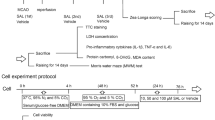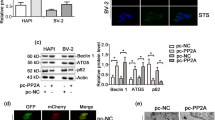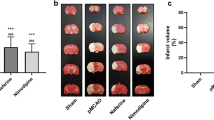Abstract
Neuronal apoptosis and oxidative stress are involved in most of the neurodegenerative diseases, promoting neuron survival is critical for therapy. Silibinin (SLB), which is derived from the seeds of Silybinisus laborinum L., has been widely used as an antioxidant. Here we tested the neuroprotective effects of SLB and the involved molecular mechanisms. We demonstrated that SLB promoted neuron viability upon hydrogen peroxide (H2O2) challenge and reduced hypoxia/ischemia injury in the middle cerebral artery occlusion (MCAO) mouse model. SLB reversed the decreased level of procaspase-3 and balanced Bcl-2 and Bax expression upon H2O2 insult to inhibit cell apoptosis. Furthermore, SLB suppressed the activation of autophagy by decreasing microtubule-associated protein 1 light chain 3 (LC3-II) and Beclin-1 levels under oxidative stress accordingly. SLB phosphorylated protein kinase B (Akt-1) at Ser473 in a time- and dose-dependent manner. The inhibitor for phosphoinositide-3-kinase (PI3K) wortmannin abrogated SLB-induced phosphorylation of Akt-1 and mTOR, decreased the suppression of autophagy, and therefore abolished SLB-mediated neuroprotection. All the data suggested that SLB protected neurons by inhibiting both the mitochondrial and autophagic cell death pathways. This study opens new avenues for the use of SLB in treatment of central nervous system (CNS) diseases in which oxidative stress plays a major role in disease pathogenesis. Given that it occurs naturally with low toxicity and pleiotropic effects that benefit the nervous system, SLB acts potentially as a novel therapy for ischemic injury.









Similar content being viewed by others
Abbreviations
- CNS:
-
Central nervous system
- DMEM/F12:
-
Dulbecco’s modified Eagle’s medium/F12
- DMSO:
-
Dimethyl sulfoxide
- HBSS:
-
Hank’s balanced salt solution
- H2O2 :
-
Hydrogen peroxide
- MTT:
-
3-(4,5-Dimethylthiazol-2-yl)-2,5-diphenyltetrazolium bromide
- PI:
-
Propidium iodide
- Bcl-2:
-
B cell lymphoma 2 protein
- Bax:
-
Bcl-2-associated X protein
- PI3K/Akt-1:
-
Phosphoinositide-3-kinase/protein kinase B
- LC3:
-
Microtubule-associated protein 1A/1B-light chain 3
- mTOR:
-
Mammalian target of rapamycin
- MCAO:
-
Middle cerebral artery occlusion
- TTC:
-
2,3,5-Triphenyltetrazolium chloride
- PVDF:
-
Polyvinylidene difluoride
- ANOVA:
-
Analysis of variance
References
Koike M, Shibata M, Tadakoshi M et al (2008) Inhibition of autophagy prevents hippocampal pyramidal neuron death after hypoxic-ischemic injury. Am J Pathol 172:454–469
Lim GP, Chu T, Yang F et al (2001) The curry spice curcumin reduces oxidative damage and amyloid pathology in an Alzheimer transgenic mouse. J Neurosci 21:8370–8377
Janda E, Isidoro C, Carresi C et al (2012) Defective autophagy in Parkinson’s disease: role of oxidative stress. Mol Neurobiol 46:639–661
Brandon-Warner E, Sugg JA, Schrum LW et al (2010) Silibinin inhibits ethanol metabolism and ethanol-dependent cell proliferation in an in vitro model of hepatocellular carcinoma. Cancer Lett 291:120–129
Yin F, Liu J, Ji X et al (2011) Silibinin: a novel inhibitor of Abeta aggregation. Neurochem Int 58:399–403
Lu P, Mamiya T, Lu LL et al (2009) Silibinin prevents amyloid beta peptide-induced memory impairment and oxidative stress in mice. Br J Pharmacol 157:1270–1277
Murata N, Murakami K, Ozawa Y et al (2010) Silymarin attenuated the amyloid beta plaque burden and improved behavioral abnormalities in an Alzheimer’s disease mouse model. Biosci Biotechnol Biochem 74:2299–2306
Hu Z, Yang B, Mo X et al. (2014) Mechanism and regulation of autophagy and its role in neuronal diseases. Mol Neurobiol
Sheng R, Liu XQ, Zhang LS et al (2012) Autophagy regulates endoplasmic reticulum stress in ischemic preconditioning. Autophagy 8:310–325
Carloni S, Albertini MC, Galluzzi L et al (2014) Increased autophagy reduces endoplasmic reticulum stress after neonatal hypoxia-ischemia: role of protein synthesis and autophagic pathways. Exp Neurol 255:103–112
Pattingre S, Tassa A, Qu X et al (2005) Bcl-2 antiapoptotic proteins inhibit Beclin 1-dependent autophagy. Cell 122:927–939
Wu Y, Peng H, Cui M et al (2009) CXCL12 increases human neural progenitor cell proliferation through Akt-1/FOXO3a signaling pathway. J Neurochem 109:1157–1167
Yang Q, Yang ZF, Liu SB et al (2010) Neuroprotective effects of hydroxysafflor yellow A against excitotoxic neuronal death partially through down-regulation of NR2B-containing NMDA receptors. Neurochem Res 35:1353–1360
Wang X, Sirianni A, Pei Z et al (2011) The melatonin MT1 receptor axis modulates mutant Huntingtin-mediated toxicity. J Neurosci 31:14496–14507
Wu YM, Jin R, Yang L et al (2013) Phosphatidylinositol 3 kinase/protein kinase B is responsible for the protection of paeoniflorin upon H(2)O(2)-induced neural progenitor cell injury. Neuroscience 240:54–62
Li YJ, Yang Q, Zhang K et al (2013) Cytisine confers neuronal protection against excitotoxic injury by down-regulating GluN2B-containing NMDA receptors. Neurotoxicology 34:219–225
Wang X, Figueroa BE, Stavrovskaya IG et al (2009) Friedlander RM: methazolamide and melatonin inhibit mitochondrial cytochrome C release and are neuroprotective in experimental models of ischemic injury. Stroke 40:1877–1885
Wen YD, Sheng R, Zhang LS et al (2008) Neuronal injury in rat model of permanent focal cerebral ischemia is associated with activation of autophagic and lysosomal pathways. Autophagy 4:762–769
St-Pierre J, Drori S, Uldry M et al (2006) Suppression of reactive oxygen species and neurodegeneration by the PGC-1 transcriptional coactivators. Cell 127:397–408
Kim J, Wong PK (2009) Loss of ATM impairs proliferation of neural stem cells through oxidative stress-mediated p38 MAPK signaling. Stem Cells 27:1987–1998
Kirkland RA, Franklin JL (2007) Bax affects production of reactive oxygen by the mitochondria of non-apoptotic neurons. Exp Neurol 204:458–461
Zhang S, Ye J, Dong G (2010) Neuroprotective effect of baicalein on hydrogen peroxide-mediated oxidative stress and mitochondrial dysfunction in PC12 cells. J Mol Neurosci 40:311–320
Maheshwari A, Misro MM, Aggarwal A et al (2011) N-acetyl-L-cysteine counteracts oxidative stress and prevents H2O2 induced germ cell apoptosis through down-regulation of caspase-9 and JNK/c-Jun. Mol Reprod Dev 78:69–79
Lee SH, Heo JS, Lee MY et al (2008) Effect of dihydrotestosterone on hydrogen peroxide-induced apoptosis of mouse embryonic stem cells. J Cell Physiol 216:269–275
Zhao H, Sapolsky RM, Steinberg GK (2006) Phosphoinositide-3-kinase/akt survival signal pathways are implicated in neuronal survival after stroke. Mol Neurobiol 34:249–270
Brazil DP, Yang ZZ, Hemmings BA (2004) Advances in protein kinase B signalling: AKTion on multiple fronts. Trends Biochem Sci 29:233–242
Rabinowitz JD, White E (2010) Autophagy and metabolism. Science 330:1344–1348
Tan CC, Yu JT, Tan MS et al (2014) Autophagy in aging and neurodegenerative diseases: implications for pathogenesis and therapy. Neurobiol Aging 35:941–957
Berlett BS, Stadtman ER (1997) Protein oxidation in aging, disease, and oxidative stress. J Biol Chem 272:20313–20316
Levine B (2007) Cell biology: autophagy and cancer. Nature 446:745–747
Li Y, Li S, Qin X et al (2014) The pleiotropic roles of sphingolipid signaling in autophagy. Cell Death Dis 5:e1245
Guerra-Araiza C, Alvarez-Mejia AL, Sanchez-Torres S et al (2013) Effect of natural exogenous antioxidants on aging and on neurodegenerative diseases. Free Radic Res 47:451–462
Schroeter H, Boyd C, Spencer JP et al (2002) MAPK signaling in neurodegeneration: influences of flavonoids and of nitric oxide. Neurobiol Aging 23:861–880
Spencer B, Potkar R, Trejo M et al (2009) Beclin 1 gene transfer activates autophagy and ameliorates the neurodegenerative pathology in alpha-synuclein models of Parkinson’s and Lewy body diseases. J Neurosci 29:13578–13588
Zoncu R, Efeyan A, Sabatini DM (2011) mTOR: from growth signal integration to cancer, diabetes and ageing. Nat Rev Mol Cell Biol 12:21–35
Antonsson B (2004) Mitochondria and the Bcl-2 family proteins in apoptosis signaling pathways. Mol Cell Biochem 256–257:141–155
Itoh N, Tsujimoto Y, Nagata S et al (1993) Effect of bcl-2 on Fas antigen-mediated cell death. J Immunol 151:621–627
Bruce-Keller AJ, Begley JG, Fu W et al (1998) Bcl-2 protects isolated plasma and mitochondrial membranes against lipid peroxidation induced by hydrogen peroxide and amyloid beta-peptide. J Neurochem 70:31–39
Acknowledgments
This work was supported financially by National Natural Science Foundation of China No. 81101457 and 81371322 (to Dr. Wu) and Scientific Research Foundation for the Returned Overseas Chinese Scholars No. HG3402 (to Dr. Wu).
Conflict of interest
The authors declare that there are no conflicts of interest.
Author information
Authors and Affiliations
Corresponding authors
Additional information
Min Wang and Yu-Jiao Li contributed equally to this study.
Rights and permissions
About this article
Cite this article
Wang, M., Li, YJ., Ding, Y. et al. Silibinin Prevents Autophagic Cell Death upon Oxidative Stress in Cortical Neurons and Cerebral Ischemia-Reperfusion Injury. Mol Neurobiol 53, 932–943 (2016). https://doi.org/10.1007/s12035-014-9062-5
Received:
Accepted:
Published:
Issue Date:
DOI: https://doi.org/10.1007/s12035-014-9062-5




